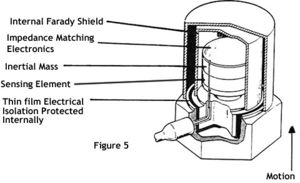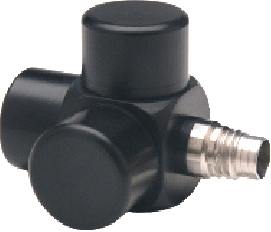Accelerometers
Accelerometer is a device that measures proper acceleration. The proper acceleration measured by an accelerometer is not necessarily the coordinate acceleration . For example, an accelerometer at rest of the surface of the earth will measure an acceleration g= 9.81 m/s2 straight upwards, due to its weight. By contrast, accelerometers in free fall or at rest in outer space will measure zero. Another term for the type of acceleration that accelerometers can measure is g-force acceleration. Accelerometers have multiple applications in industry and science. Highly sensitive accelerometers are components of inertial navigation systems for aircraft and missiles. Accelerometers are used to detect and monitor vibration in rotating machinery. Accelerometers are used in tablet computers and digital cameras so that images on screens are always displayed upright.
Single- and multi-axis models of accelerometer are available to detect magnitude and direction of the proper acceleration , as a vectorquantity, and can be used to sense orientation , coordinate acceleration , vibration, shock, and falling in a resistive medium. Micromachined accelerometers are increasingly present in portable electronic devices and video game controllers, to detect the position of the device or provide for game input. Pairs of accelerometers extended over a region of space can be used to detect differences in the proper accelerations of frames of references associated with those points. These devices are called gravity gradiometers, as they measure gradients in the gravitational field. Such pairs of accelerometers in theory may also be able to detect gravitational waves.
Physical principles
An accelerometer measures proper acceleration, which is the acceleration it experiences relative to freefall and is the acceleration felt by people and objects. Put another way, at any point in spacetime the equivalence principle guarantees the existence of a local inertial frame, and an accelerometer measures the acceleration relative to that frame.Such accelerations are popularly measured in terms of g-force. An accelerometer at rest relative to the Earth's surface will indicate approximately 1 g upwards, because any point on the Earth's surface is accelerating upwards relative to the local inertial frame . To obtain the acceleration due to motion with respect to the Earth, this gravity offset must be subtracted and corrections for effects caused by the Earth's rotation relative to the inertial frame. The reason for the appearance of a gravitational offset is Einstein's equivalence principle,which states that the effects of gravity on an object are indistinguishable from acceleration. When held fixed in a gravitational field by, for example, applying a ground reaction force or an equivalent upward thrust, the reference frame for an accelerometer accelerates upwards with respect to a free-falling reference frame. The effects of this acceleration are indistinguishable from any other acceleration experienced by the instrument, so that an accelerometer cannot detect the difference between sitting in a rocket on the launch pad, and being in the same rocket in deep space while it uses its engines to accelerate at 1 g. For similar reasons, an accelerometer will read zero during any type of free fall. This includes use in a coasting spaceship in deep space far from any mass, a spaceship orbiting the Earth, an airplane in a parabolic zero-g arc, or any free-fall in vacuum. Another example is free-fall at a sufficiently high altitude that atmospheric effects can be neglected.
However this does not include a non-free fall in which air resistance produces drag forces that reduce the acceleration, until constant terminal velocity is reached. At terminal velocity the accelerometer will indicate 1 g acceleration upwards. For the same reason a skydiver, upon reaching terminal velocity, does not feel as though he or she were in free-fall, but rather experiences a feeling similar to being supported on a bed of uprushing air. Acceleration is quantified in the SI unit metres per second per second (m/s2), in the cgs unit gal (Gal), or popularly in terms of g-force (g).
For the practical purpose of finding the acceleration of objects with respect to the Earth, such as for use in an inertial navigation system, a knowledge of local gravity is required. This can be obtained either by calibrating the device at rest,or from a known model of gravity at the approximate current position.
Structure
Conceptually, an accelerometer behaves as a damped mass on a spring. When the accelerometer experiences an acceleration, the mass is displaced to the point that the spring is able to accelerate the mass at the same rate as the casing. The displacement is then measured to give the acceleration.
In commercial devices, piezoelectric, piezoresistive and capacitive components are commonly used to convert the mechanical motion into an electrical signal. Piezoelectric accelerometers rely on piezoceramics or single crystals . They are unmatched in terms of their upper frequency range, low packaged weight and high temperature range. Piezoresistive accelerometers are preferred in high shock applications. Capacitive accelerometers typically use a silicon micro-machined sensing element. Their performance is superior in the low frequency range and they can be operated in servo mode to achieve high stability and linearity. Modern accelerometers are often small micro electro-mechanical systems , and are indeed the simplest micro electro-mechanical systems devices possible, consisting of little more than a cantilever beam with a proof mass . Damping results from the residual gas sealed in the device. As long as the Q-factor is not too low, damping does not result in a lower sensitivity.
Under the influence of external accelerations the proof mass deflects from its neutral position. This deflection is measured in an analog or digital manner. Most commonly, the capacitance between a set of fixed beams and a set of beams attached to the proof mass is measured. This method is simple, reliable, and inexpensive. Integrating piezoresistors in the springs to detect spring deformation, and thus deflection, is a good alternative, although a few more process steps are needed during the fabrication sequence. For very high sensitivities quantum tunneling is also used; this requires a dedicated process making it very expensive. Optical measurement has been demonstrated on laboratory scale. Another, far less common, type of micro electro-mechanical systems-based accelerometer contains a small heater at the bottom of a very small dome, which heats the air inside the dome to cause it to rise. A thermocouple on the dome determines where the heated air reaches the dome and the deflection off the center is a measure of the acceleration applied to the sensor.
Most micromechanical accelerometers operate in-plane, that is, they are designed to be sensitive only to a direction in the plane of the die. By integrating two devices perpendicularly on a single die a two-axis accelerometer can be made. By adding an additional out-of-plane device three axes can be measured. Such a combination may have much lower misalignment error than three discrete models combined after packaging. Micromechanical accelerometers are available in a wide variety of measuring ranges, reaching up to thousands of g's. The designer must make a compromise between sensitivity and the maximum acceleration that can be measured.

